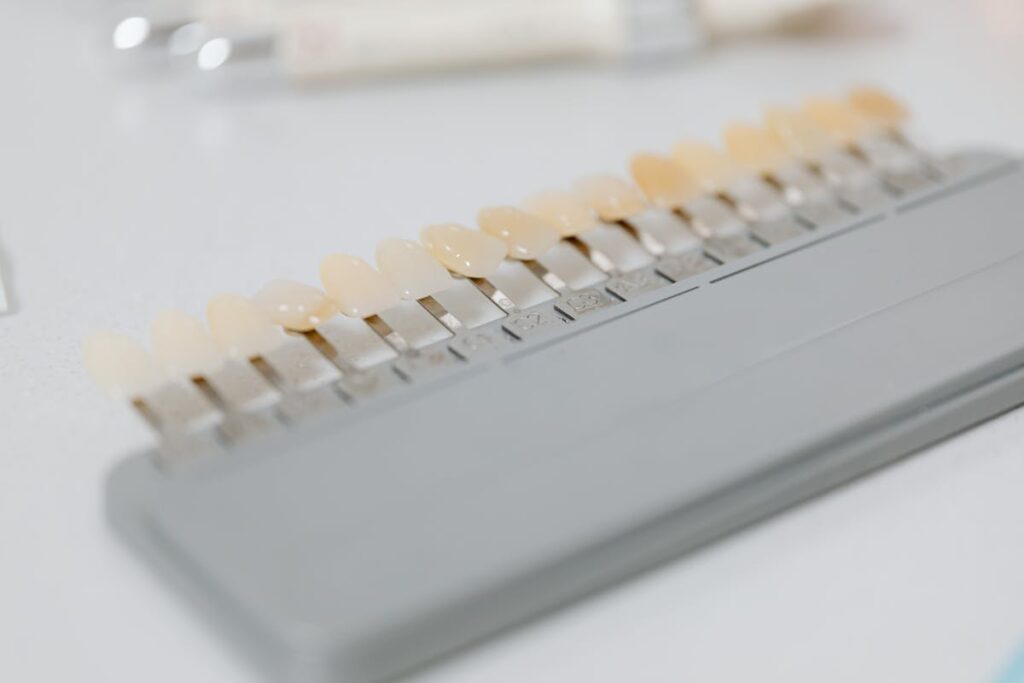Veneers, often associated with the transformative power to enhance the aesthetics of front teeth, are generally perceived to be solely a cosmetic solution. However, the scope of their application extends beyond the domain of merely cosmetic enhancement. The question then arises – can veneers be used effectively on back teeth such as premolars and molars? Pondering this question unravels a broader discussion concerning the thorough functionality and versatility of veneers in addressing various dental issues, a discussion that may challenge your current understanding of veneer use.
Understanding Dental Veneers
While some may be unfamiliar with the concept, dental veneers are a common solution in cosmetic dentistry for improving the appearance of your teeth. Fundamentally, veneers are thin, custom-made shells designed to cover the front surface of teeth, enhancing dental aesthetics and protecting the tooth’s surface from damage.
Veneer materials include porcelain and composite resin, each with their unique advantages. Porcelain veneers are often preferred for their ability to mimic the light-reflecting properties of natural teeth better than resin veneers. They are also more resistant to staining and wear, making them a durable choice. On the other hand, composite resin veneers require less removal of the tooth surface before placement, preserving more of the natural tooth structure.
The selection of veneer materials is a critical factor in achieving the desired dental aesthetics. The material’s color, translucency, and texture should match the patient’s natural teeth as closely as possible. This requires the expertise of dental professionals who can assess the patient’s dental health, consider their cosmetic goals, and recommend the most suitable veneer material.
Common Applications of Veneers
Countless individuals turn to dental veneers as a solution for various cosmetic and functional dental problems. Veneers can transform a smile, adding symmetry, and improving color, shape, and size of teeth. Although commonly applied to the front teeth, veneers are not limited to this area.
In fact, dental veneers are often used to enhance back teeth aesthetics. They can correct issues such as discoloration, fractures or chips, and unevenness in the back teeth, boosting the overall appearance of the smile. Not only do veneers improve dental aesthetics, they also provide a layer of protection, which can help preserve the tooth structure.
Veneer longevity is another significant aspect that adds to their appeal. With proper care and maintenance, veneers can last for many years, making them a long-term solution for a wide range of dental issues. It’s crucial to recognize that while veneers are a durable solution, they still require regular dental checkups and good oral hygiene practices to maintain their longevity.
The Front Teeth Veneers Myth
Many people labor under the misconception that veneers are only applicable for front teeth, a myth that has unfortunately led to a lack of understanding about the full potential and versatility of these dental solutions. Such veneer misconceptions often stem from the prominence of front teeth in aesthetic dentistry. Indeed, veneers are widely used to correct aesthetic issues of the front teeth, such as discoloration, chips, cracks, or gaps. However, this does not preclude their use on other teeth.
The truth is that veneers can be used on any tooth, provided the structure and health of the tooth allows it. The limitations of veneers are not determined by their location in the mouth, but rather by the specific dental needs and overall oral health of each individual patient. While it is true that front teeth are the most common recipients of veneers due to their visibility, this does not mean veneers are exclusive to them.
To dispel this myth, it is essential to understand veneers in their entirety, taking into account their function, benefits, and scope of application. Only then can patients fully utilize the potential of veneers to improve their dental health and aesthetics.
Veneer Placement: Beyond Front Teeth
You may be surprised to learn that veneer placement is not limited to front teeth. Indeed, the versatility of this dental solution extends beyond the anterior segment, offering a thorough approach to both veneers aesthetics and dental health.
Veneers are thin, custom-made shells designed to cover the surface of teeth, improving their appearance and protecting them from damage. While typically associated with front teeth mainly due to aesthetic concerns, veneers can also be placed on premolars and molars. This broadens the scope of their application, providing an all-encompassing solution to various dental concerns.
The use of veneers on back teeth may not be as visually apparent as their placement on front teeth, but it carries significant benefits. These include the restoration of tooth structure and function, and protection against further damage, particularly in cases of worn-down or fractured teeth. Furthermore, they can enhance dental health by rectifying malocclusion issues and improving bite alignment.

Factors Influencing Veneer Placement
Several factors come into play when considering the placement of veneers, each essential in its own right for ensuring the success and longevity of the treatment.
Tooth structure is a prime determinant, as the existing condition and strength of the tooth can impact the veneer’s adherence and durability. Dentists examine factors like enamel thickness, tooth alignment, and the presence of any decay or damage before proceeding with the treatment.
Patient preferences also greatly influence veneer placement. Their aesthetic goals, comfort, and willingness to undergo potentially invasive procedures all form part of the decision-making process. Some patients may prefer a more natural look that only requires veneers on the front teeth, while others might prefer a more extensive solution involving both front and back teeth.
Furthermore, the patient’s oral hygiene habits, including their commitment to regular brushing and flossing, can affect the longevity of the veneers. Without proper care, veneers can dislodge or become discolored.
Lastly, the dentist’s expertise and skills play a vital role. The ability to accurately assess the patient’s tooth structure and to carefully listen to and understand the patient’s preferences can greatly improve the treatment’s success.
Advantages of Veneers on Back Teeth
Opting for veneers on back teeth presents a multitude of benefits for the patient’s oral health and overall aesthetic appeal. These dental prosthetics are not merely limited to the front teeth, as commonly perceived. In fact, when placed on the back teeth, they offer significant advantages.
One primary benefit of veneers on back teeth is their ability to correct structural issues. They can effectively rectify worn down, cracked, or damaged teeth, thus alleviating discomfort and improving functionality. This is particularly beneficial for the molars, which play an essential role in grinding food.
Another compelling advantage is the aesthetic enhancement. Veneers can seamlessly match the natural color of the patient’s teeth, ensuring an unnoticeable shift between the veneered and non-veneered teeth. Consequently, they offer a thorough solution for patients seeking a uniform and attractive smile.
Furthermore, veneers on the back teeth can aid in maintaining proper bite alignment, which is vital for efficient chewing and overall oral health. They can also provide additional strength to the back teeth, thus preventing further damage.
Potential Drawbacks of Back Teeth Veneers
While veneers on back teeth offer numerous benefits, it is equally important to assess potential drawbacks to make an informed decision. One of the foremost back teeth factors when contemplating veneers is the longevity of the treatment.
Veneer longevity is typically less for back teeth than for front teeth. This is primarily due to the higher chewing forces exerted on the posterior teeth, which may lead to potential chipping, breaking, or dislodging of the veneer over time. Additionally, the application of veneers on back teeth can be more challenging due to the limited access and visibility. This may result in less than ideal fit and aesthetic outcomes.
There is also the cost factor to take into account. Veneers, particularly porcelain ones, can be expensive and the procedure is usually not covered by dental insurance as it is considered a cosmetic treatment. Furthermore, the process is generally irreversible, meaning once you have a tooth prepared for a veneer, the structure removed cannot be replaced.
Finally, like any dental procedure, there could be potential risks of sensitivity or infection. Hence, it is important to carefully weigh the benefits against these potential drawbacks when evaluating veneers for back teeth.
Making the Right Veneer Decision
The decision to get veneers, especially for back teeth, requires careful consideration and consultation with a dental professional. Various factors need to be evaluated, such as the choice of veneer materials and the patient’s commitment to veneer maintenance.
Veneer materials range from porcelain to composite resins. Each material has its unique benefits and drawbacks, affecting factors such as durability, aesthetics, and cost. For instance, porcelain veneers are renowned for their superior aesthetics and durability but come at a higher cost. On the other hand, composite resin veneers are less expensive but may not offer the same longevity or aesthetic appeal as their porcelain counterparts.
Veneer maintenance is equally important in making this decision. Regardless of the chosen material, veneers require regular cleaning to prevent discoloration and decay beneath the veneer. Regular dental check-ups are also necessary to guarantee the veneer remains in good condition and any potential issues are promptly addressed.
Frequently Asked Questions
What Is the Average Cost of Dental Veneers?
The average cost of dental veneers can vary considerably based on veneer types, location, and dentist’s expertise. Generally, prices range from $250 to $2,500 per tooth, making extensive treatment a substantial investment.
How Long Do Dental Veneers Typically Last?
Dental veneers typically last between 10 to 15 years. Longevity factors include the quality of the veneer and oral hygiene habits. Regular check-ups and good oral care are essential maintenance tips for veneer durability.
Are There Any Alternatives to Dental Veneers?
Yes, there are several alternatives to dental veneers. Composite bonding and dental crowns are commonly used options. These methods can effectively address dental issues like discoloration, damage, or misalignment, similar to veneers.
What Is the Process of Getting Dental Veneers?
The veneers procedure begins with a dental consultation to assess suitability. Then, teeth are prepared by removing a small amount of enamel. Impressions are taken to custom-make the veneers, which are then bonded to the teeth.
Are Dental Veneers Covered by Insurance?
Dental insurance coverage for veneers varies greatly. Some insurance plans may provide partial coverage under certain conditions, while others may exclude it entirely. It’s essential to consult with your insurance provider about your specific coverage options.
